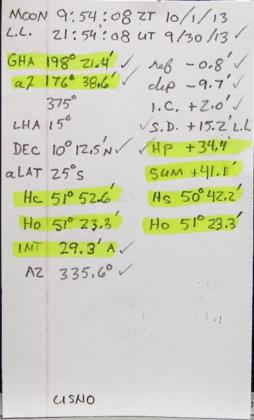
NavList:
A Community Devoted to the Preservation and Practice of Celestial Navigation and Other Methods of Traditional Wayfinding
From: Greg Rudzinski
Date: 2013 Apr 23, 12:47 -0700
Antoine,
For 1 September 2013 L.L. Moon 20:05:55 UT
A USNO check showed a 0.1' difference in the previously reduced Hc. The updated intercept is 20.4 T giving us a difference of 0.3'.
For 30 September 2013 L.L. Moon 21:54:08 UT
A USNO check showed multiple small changes (see attached highlighted items).
Greg Rudzinski
USCG Student Sample Problems #1, #2 and #3
From: Antoine Couëtte
Date: 2013 Apr 21, 13:04 -0700
Dear all, and especially Dear Greg, Peter and Yves
Thanks a lot, Greg, for pre-submitting us these very interesting 3 different Sample Problems.
Since you have spent a lot of time on building them up, I decided that I should do the same through carefully and thoroughly checking your figures from a totally independent software source.
ALL DATES AND TIMES HERE-UNDER ARE IN THE UT1 SYSTEM.
I first computed all Body Apparent Celestial Coordinates for the 3 dates given : one maximum error reached 0.2' - most certainly attributable to round-offs - and all others were within 0.1' . So far, so good.
I then undertook to recompute all your data (Intercepts and Azimuths) with the very same "Auxiliary Positions" as the ones you have been using. Apart from what might seem an uncorrected intercept for the SUN on JUN. 02nd , 2013 and with 2 exceptions reaching 0.4 NM for Polaris on Jun. 02nd, 2013 and 0.4 NM for the Moon on Sep. 01st, 2013 - which I will elaborate on further down - , all intercept differences are within 0.2 NM, here again attributable to round-off errors, as well as to a slightly different DIP Formula which I am using.
Here are my results for each of these 3 days :
1 - 02 JUNE 2013
RE : " https://NavList.net/m2.aspx/Group-Project-USCG-student-sample-problems-Rudzinski-apr-2013-g23582 " further corrected into :
" https://NavList.net/m2.aspx/Group-Project-USCG-student-sample-problems-Rudzinski-apr-2013-g23599 " after first feedback from Peter Hakel.
I confirm all corrections first and earlier indicated by Peter.
However for the 01:59:04 UT SUN observation, Greg, I am getting an Intercept of 8.9 NM TO (vs. your - uncorrected ?? - value of 17.0 T) while we are both getting the same Azimuths (Az = 283.4 °).
I have also computed the Observer's Position by a different algorithm which updates the Observer's DR positions for each observation time :
- If we give all bodies the same weights, the Observed position is : UT 05:00:00 / N 23°24'9 / W 143°40'1 (or UT 05:00:31 / N 23°24'8 / W 143°40'3) and the LOP's Dispersion is 1.0 NM, which is fair.
- If we decide to "force" the Latitude derived from From Polaris into our Fix, then such Fix becomes : UT 05:00:31 / N 23°23'6 / W 143°40'3 (or UT 05:00:00 / N 23°23'7 / W 143° 40'1)
- In other words, the Latitude as derived by Polaris is N 23°23'6 and it stands for the exact time of the Polaris Observation, i.e. UT 05:00:31 . I could not reconcile this latter Polaris derived Latitude with your published values (i.e. UT 05:00:31 / N 23°24'0). There remains an unexplained (sizable) difference of 0.4' between our results.
2 - 01 SEP 2013
RE : " https://NavList.net/m2.aspx/USCG-Sample-Problem-2-for-Southern-Hemisphere-Rudzinski-apr-2013-g23605 "
The only significant difference between our results concerns your Moon Intercept : You are getting 20.5 T / 336.9 ° while I am getting 20.1 T / 336°9
I concur with your SD value of 15.0' which is extremely close from the Augmented value I have derived.
I observe a significant difference on the Parallax Correction. With HP=54'4 and H topocentric very close from 62° I am getting HP = 25.5' while you are using 25.8'. These 0.3' explain most our result difference, with the remainder attributable to round-offs.
I have also computed the Observer's Position by a different algorithm which updates the Observer's DR positions for each observation time :
- If we give all bodies the same weights, the Observed position is : UT 20:00:00 UT / S 09°41'3 / W 152°43'8 and the LOP's Dispersion is exactly 0.0 NM (well done !). As earlier, such an Algorithm is believed to yield a position which should be more accurate "per se / in essence" since the obtained intercepts are generally much smaller than the ones usually yielded by the traditional HOxxx tables Auxiliary Positions.
03 - 30 SEP 2013
I concur with all your results for that date.
I have also computed the Observer's Position by a different algorithm which updates the Observer's DR positions for each observation time :
- If we give all bodies the same weights, the Observed position is : UT 17:00:00 UT / S 25°08'4 / E 178°44'6 and the LOP's Dispersion is 0.4 NM (quite good).
Again such position is believed to be more accurate "per se / in essence" since the intercepts are much smaller than the ones usually yielded by the traditional Auxiliary Positions.
Finally I have computed your last SUN-MOON LOP's as a totally independent Fix. I am finding :
UT 22:00:00 / S 25°26'2 / E 176°51'2 , with "no dispersion" since there are only 2 LOP's .
Thank you very much for this new number-crunching opportunity.
Hopefully no typo ... I'm crossing my Fingers.
I will kindly listen to any feedback since this is an excellent opportunity to verify numbers. If something is wrong in my results, it will be an opportunity to improve them. Thanks in advance to anybody questioning them.
Best Regards to all
Kermit
Antoine M. Couëtte
-----
----------------------------------------------------------------
NavList message boards and member settings: www.fer3.com/NavList
Members may optionally receive posts by email.
To cancel email delivery, send a message to NoMail[at]fer3.com
----------------------------------------------------------------







